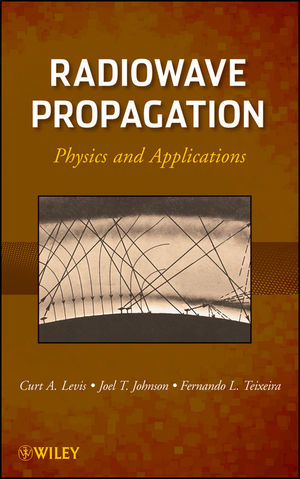
Radiowave Propagation
John Wiley & Sons Inc (Verlag)
978-0-470-54295-8 (ISBN)
An accessible student-oriented approach to radiowave propagation Propagation-the process whereby a signal is conveyed between transmitter and receiver-has a profound influence on communication systems design. Radiowave Propagation provides an overview of the physical mechanisms that govern electromagnetic wave propagation in the Earth's troposphere and ionosphere. Developed in conjunction with a graduate-level wave propagation course at The Ohio State University, this text offers a balance of physical and empirical models to provide basic physical insight as well as practical methods for system design.
Beginning with discussions of propagation media properties, plane waves, and antenna and system concepts, successive chapters consider the most important wave propagation mechanisms for frequencies ranging from LF up to the millimeter wave range, including:
Direct line-of-sight propagation through the atmosphere
Rain attenuation
The basic theory of reflection and refraction at material interfaces and in the Earth's atmosphere
Reflection, refraction, and diffraction analysis in microwave link design for a specified terrain profile
Empirical path loss models for point-to-point ground links
Statistical fading models
Standard techniques for prediction of ground wave propagation
Ionospheric propagation, with emphasis on the skywave mechanism at MF and HF and on ionospheric perturbations for Earth-space links at VHF and higher frequencies
A survey of other propagation mechanisms, including tropospheric scatter, meteor scatter, and propagation effects on GPS systems
Radiowave Propagation incorporates fundamental materials to help senior undergraduate and graduate engineering students review and strengthen electromagnetic physics skills as well as the most current empirical methods recommended by the International Telecommunication Union. This book can also serve as a valuable teaching and reference text for engineers working with wireless communication, radar, or remote sensing systems.
Curt A. Levis was director of The Ohio State University ElectroScience Laboratory from 1961 to 1969. He received the Eta Kappa Nu Distinguished Teaching Award in 1978, 1979, and 1980; he also received a Distinguished Teaching Award from The Ohio State University Alumni Association in 1980. Professor Levis is an IEEE Fellow. Joel T. Johnson is a professor in the Department of Electrical and Computer Engineering and ElectroScience Laboratory at The Ohio State University. His research interests are in the areas of electromagnetics, propagation, and microwave remote sensing. He is an IEEE Fellow and a recipient of the ONR Young Investigator, PECASE, and NSF CAREER awards. Fernando L. Teixeira is an associate professor in the Department of Electrical and Computer Engineering and ElectroScience Laboratory at The Ohio State University, as well as Associate Editor for IEEE Antennas and Wireless Propagation Letters. He is a recipient of the NSF CAREER Award and the triennial USNC-URSI Booker Fellowship.
Preface. 1 Introduction.
1.1 Definition of Propagation.
1.2 Propagation and Systems Design.
1.3 Historical Perspective.
1.4 The Influence of Signal Frequency and Environment.
1.5 Propagation Mechanisms.
1.6 Summary.
1.7 Sources of Further Information.
1.8 Overview of Text.
2 Characterization of Propagation Media.
2.1 Introduction.
2.2 Maxwell’s Equations, Boundary Conditions, and Continuity.
2.3 Constitutive Relations.
2.4 Dielectric Behavior of Materials: Material Polarization.
2.5 Material Properties.
2.5.1 Simple Media.
2.6 Magnetic and Conductive Behavior of Materials.
References.
3 Plane Waves.
3.1 Introduction.
3.2 D’Alembert’s Solution.
3.3 Pure Traveling Waves.
3.4 Information Transmission.
3.5 Sinusoidal Time Dependence in an Ideal Medium.
3.6 Plane Waves in Lossy and Dispersive Media.
3.7 Phase and Group Velocity.
3.8 Wave Polarization.
References.
4 Antenna and Noise Concepts.
4.1 Introduction.
4.2 Antenna Concepts.
4.3 Basic Parameters of Antennas.
4.3.1 Receiving Antennas.
4.4 Noise Considerations.
References.
5 Direct Transmission.
5.1 Introduction.
5.2 Friis Transmission Formula.
5.3 Atmospheric Gas Attenuation Effects.
5.4 Rain Attenuation.
5.5 Scintillations.
Appendix 5.A Look Angles to Geostationary Satellites.
References.
6 Reflection and Refraction.
6.1 Introduction.
6.2 Reflection from a Planar Interface: Normal Incidence.
6.3 Reflection from a Planar Interface: Oblique Incidence.
6.4 Total Reflection and Critical Angle.
6.5 Refraction in a Stratified Medium.
6.6 Refraction Over a Spherical Earth.
6.7 Refraction in the Earth’s Atmosphere.
6.8 Ducting.
6.9 Ray-Tracing Methods.
References.
7 Terrain Reflection and Diffraction.
7.1 Introduction.
7.2 Propagation Over a Plane Earth.
7.3 Fresnel Zones.
7.4 Earth Curvature and Path Profile Construction.
7.5 Microwave Link Design.
7.6 Path Loss Analysis Examples.
7.7 Numerical Methods for Path Loss Analysis.
7.8 Conclusion.
References.
8 Empirical Path Loss and Fading Models.
8.1 Introduction.
8.2 Empirical Path Loss Models.
8.3 Signal Fading.
8.4 Narrowband Fading Mitigation Using Diversity Schemes.
8.5 Wideband Channels.
8.6 Conclusion.
References.
9 Groundwave Propagation.
9.1 Introduction.
9.2 Planar Earth Groundwave Prediction.
9.3 Spherical Earth Groundwave Prediction.
9.4 Methods for Approximate Calculations.
9.5 A 1 MHz Sample Calculation.
9.6 A 10 MHz Sample Calculation.
9.7 ITU Information and Other Resources.
9.8 Summary.
Appendix 9.A Spherical Earth Groundwave Computations.
References.
10 Characteristics of the Ionosphere.
10.1 Introduction.
10.2 The Barometric Law.
10.3 Chapman’s Theory.
10.4 Structure of the Ionosphere.
10.5 Variability of the Ionosphere.
References.
11 Ionospheric Propagation.
11.1 Introduction.
11.2 Dielectric Properties of an Ionized Medium.
11.3 Propagation in a Magnetoionic Medium.
11.4 Ionospheric Propagation Characteristics.
11.5 Ionospheric Sounding.
11.6 The Secant Law.
11.7 Transmission Curves.
11.8 Breit and Tuve’s Theorem.
11.9 Martyn’s Theorem on Equivalent Virtual Heights.
11.10 MUF, "Skip" Distance, and Ionospheric Signal Dispersion.
11.11 Earth Curvature Effects and Ray-Tracing Techniques.
11.12 Ionospheric Propagation Prediction Tools.
11.13 Ionospheric Absorption.
11.14 Ionospheric Effects on Earth–Space Links.
References.
12 Other Propagation Mechanisms and Applications.
12.1 Introduction.
12.2 Tropospheric Scatter.
12.3 Meteor Scatter.
12.4 Tropospheric Delay in Global Satellite Navigation Systems.
12.5 Propagation Effects on Radar Systems.
References.
Index.
| Verlagsort | New York |
|---|---|
| Sprache | englisch |
| Maße | 163 x 246 mm |
| Gewicht | 590 g |
| Themenwelt | Naturwissenschaften ► Physik / Astronomie ► Elektrodynamik |
| Technik ► Elektrotechnik / Energietechnik | |
| Technik ► Nachrichtentechnik | |
| ISBN-10 | 0-470-54295-0 / 0470542950 |
| ISBN-13 | 978-0-470-54295-8 / 9780470542958 |
| Zustand | Neuware |
| Haben Sie eine Frage zum Produkt? |
aus dem Bereich


